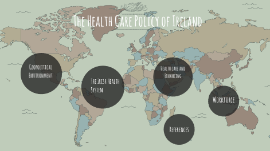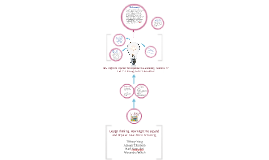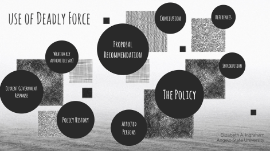Policy powerpoint
Transcript: Elizabeth A. Ingraham Angelo State University use of Deadly Force Introduction One of the most prevalent social justice issues of recent years is the insurgence of police shootings on unarmed civilians. This has shown to be an alarming violation of human rights as American citizens, particularly minorities, are being harmed for unsubstantial reasons, with little to no repercussions. In light of these incidences the Use of Deadly Force law will be analyzed. Introduction The Policy The Policy Use of Deadly Force In Section 1047.7 of the public law under the Code of Federal Regulations the legal allowances and defintions of deadly force are dileniated The law The law What is Deadly Force? What is Deadly Force? Deadly Force Deadly Force According to the statute: "force which a reasonable person would consider likely to cause death or serious bodily harm" "Its use may be justified only under conditions of extreme necessity, when all lesser means have failed or cannot reasonably be employed" Officers are authorized under: Officers are authorized under: "Self Defense" "Serious Offences against other persons" "Nuclear Weapons" "special Nuclear Material" "Apprehension" (Use of Deadly Force, 2011). "When deadly force reasonably appears to be necessary to protect a protective force officer who reasonably believes himself or herself to be in imminent danger of death or serious bodily harm" Self-Defense Self-Defense (Use of Deadly Force, 2011). **This is a allows for a fairly subjective definition of what qualifies as self-defense Affected Persons Affected Persons an article from Policeone.com claims: An average of 358 police committed killings each year from 1991 to 2008 461 in 2013 These are legally referred to as "justifiable homicide" (Dwyer, 2010). Social Justice Social Justice It a social justice issue whether or not police should be allowed the authority to be "judge jury and executioner" (Amnesty International, 2015). Discrimination Discrimination The main reason this has been such a hot-button topic is the "dispraportionate" amount of unarmed African-American men that are being killed (Amnesty International, 2015). This leaves many different groups of men, women, and youths in unreasonable fear, violating their rights as equal citizens Perpetuates racism; furthers expectations of racism, corruption, disregard from police officers Regardless of what the law is supposed to imply, the intended or unintended consequences are that large amounts of minorities are losing their lives because of this Economic Justice Economic Justice This affects the economy by: creating lack of trust in police, lessens overall police functionality financial costs of representing officers when sued by families cost of restitution Incitement of protesting (both riots and peaceful) This affects the environment by: putting bystanders at risk with multiple shots being fired in urban areas creating fear in communities further discord between police and minority groups creates a perceived need for civilians to be armed in order to protect themselves Environmental Justice Environmental Justice Policy History Policy History TIMELINE TIMELINE Tennesse v. Garner created the statute for allowed force when other officers in people in threat of harm/death "fleeing felon" Rodney King beaten nearly to death by 4 officers w/ 'deadly weapons" (batons) -acquittal of police caused LA riots (1992)- 63 killed, 2,000 injured... led to 2 officers sentenced to 30 mo. Graham v. Connor established 'objective reasonableness' -use of 'force continuum' FL v. George Zimmerman George Zimmerman is acquitted in the shooting of Trayvon Martin -calls for national debate -upheld 'stand your ground', a law in 28 states, practice in 8 more 2017 Common-law rule: use of force only in self-defence *Common-law rule - law determined by judge mandates or court rulings (Flanders & Welling, 2016) 1985 1989 1991 2013 George Zimmerman was not an official officer, though he worked for a law enforcement authorized group Implies that these laws can be upheld under "self-defence" for untrained persons Many interest groups formed, but no resolution is yet to be put into action There are, of course, many other incidences, but it would be hard to list them all, some include: Eula Love, 1979 Amadou Diallo, 1999 Kelly Thomas, 2011 Michael Brown, 2014 Eric Garner, 2014 James Boyd, 2014 Notes: Notes: (La Ganga & Susman, 2014). Current Government Response Current Government Response Local government polices vary greatly, each county/city has own police force and individualized policies largely affected by the prevalence of violence in the community Local courts decide interpretation of the law unless it is appealed and sent to higher courts self-defense, defense of a third party, and protection of property are continued allowances for most southern state counties largely expected for people to carry weapons, and large support of deadly weapons Local Government Local Government State Government In

















